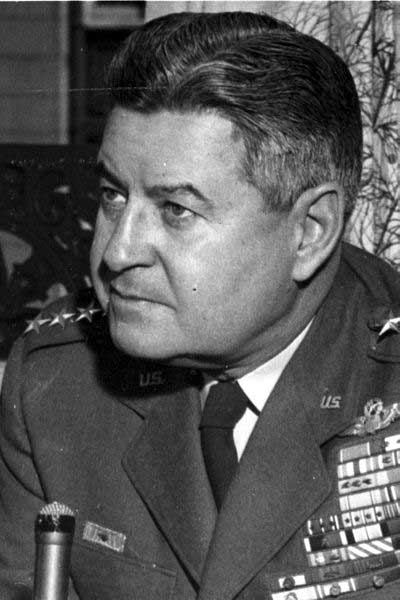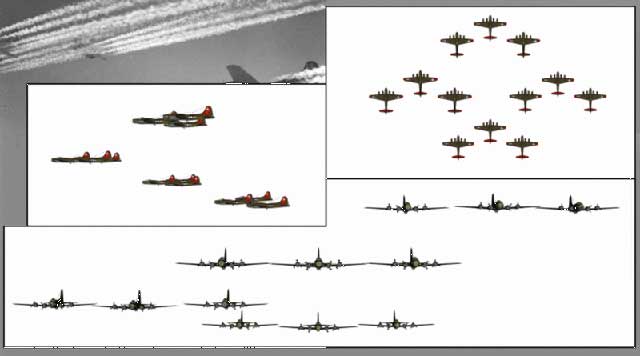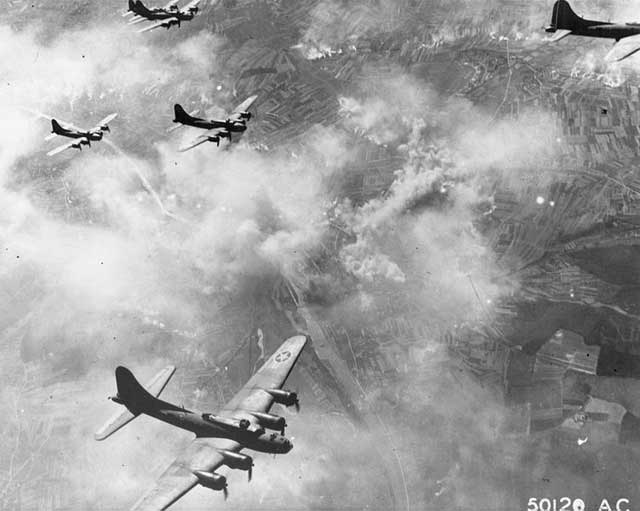The Schweinfurt Raids 1943
General Curtis Lemay wanted to clean Germany's clock. What he had to do it with was the most heavily gunned bomber force in history. He was running missions just inside Germany but he wanted to go for the gold. The planners wanted the ball bearing factories, but they were deep into Germany, far beyond any fighter escort available at the time. LeMay knew his guys could do it.

General Curtis LeMay
Curtis LeMay wasn't one to be left behind, he flew the lead bomber. Each ship had 10 crew, and guns bristled out every end. He was a firm believer in the bomber doctrine that said if you had enough bombers with enough guns close to each other, they would form a box that an enemy fighter couldn't penetrate and live. In effect they could defend themselves and didn't require fighter escort. The Schweinfurt raids would prove the point. It proved that it didn't work.

The Combat Box - image by wikimedia contributor anynobody
The first raid in August, 1943 was a dual raid, Regensburg and the Messerschmitt factories, and Schweinfurt with the ball bearing factories. The intent was to raid both cities at once, splitting up the fighter defense, but fog delayed the Schweinfurt crews, and German fighters had plenty of time to pummel the Regensburg force, refuel and rearm and take on the planes heading for Schweinfurt. Nineteen percent of the aircraft participating were shot down. Hundreds of fighters assailed both bomber streams, and from their close positions in the 'combat box', flak took their toll too. 600 aircrew were lost to the Allies, almost 400 were captured. Of the planes that made it back, many would never fly again.
The German factories took a beating too, and Albert Speer, the German Armaments Minister, was getting nervous. British area bombing didn't bother him so much, but the Americans and their pinpoint attacks on German war industry was another thing. Without ball bearings, Speer's war machine would come to a complete halt. His aircraft were already running though millions of ball bearings a month. Ball bearing output dropped 38%, and the lost production of Bf-109's amounted to about 1000 planes. The mission accomplished it's goal.

B-17's over Schweinfurt
Schweinfurt was hit again in October, and again without escort. Lemay was promoted out of his aircraft (they didn't want to lose him.) and 291 B-17's crossed the German border and watched the P-47's turn back, running low on fuel. There were 1000 German fighters available and it seemed that every one of them took a shot at the bomber force. Planes were dropping everywhere, flak was telling too. 60 of the big bombers were lost, many that made it back were written off as unrepairable. Losses were way over 20%. Ball bearing production dropped so much that Albert Speer tried to buy ball bearings from Sweden.

Battle damaged B-17 limping home
The raids were a pyrrhic victory. German war industry was in disarray, but morale in the bomber crews had sunk to a new low. The fliers weren't stupid, they could see that if they kept this up, there wouldn't be any bomber crews alive to go home again. It was painfully obvious that escort fighters would be needed to be successful. By December, 1943, the P-51 arrived on the scene, and with it came an escort fighter with long enough legs to keep up with the bombers no matter where they went.
Video from the Periscope Film's channel

